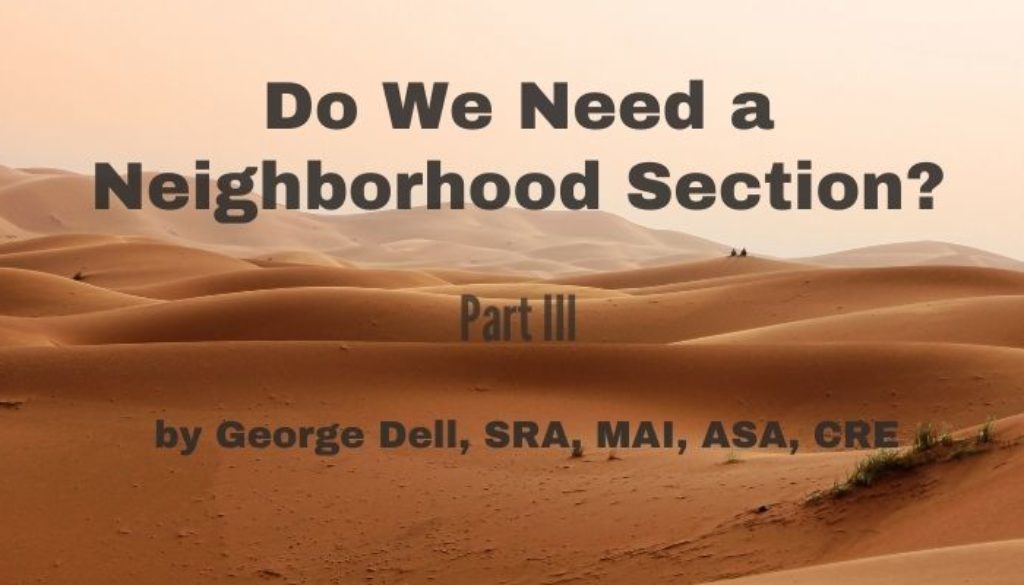Market area, District, Neighborhood – what do our directives say? Let’s take a look at standards, education, regulations, and the GSE (Government Sponsored Enterprises).
First, let’s set a goal: What is the ideal comparable data to analyze? How big, how similar, and how competitive should it be?
Read Part I and Part II of Do We Need a Neighborhood Section?
The Appraisal of Real Estate (TARE) says the data should be similar, competitive, and able to be compared. Sadly, this is a circular explanation. You could say “a comparable is able to be compared.” No factual, logical, or numerical gauge of ‘similarity’ is offered.
The GSE’s standard form 1004 requires an appraiser certification, which states: “I selected and used comparable sales that are locationally, physically, and functionally the most similar to the subject property.” You could say that therefore there are comparable sales which are not locationally, physically, and functionally similar!
USPAP (Uniform Standards of Professional Appraisal Practice), the official non-official STANDARDS RULE 1-3(a) mentions “market area trends” but does not define a “market.” STANDARDS RULE 1-4(a) requires the appraiser to analyze “comparable sales data.” It also does not define “comparable.”
Interesting. An appraiser is required to report on something which is not defined, and not measurable – but must be analyzed. Just do it! And specifically – report the trend of whatever it is.
Regulations mostly just require compliance with USPAP, and place looser requirements on ‘evaluation’. Outputs from AVMs are non-regulated.
And of course, the appraiser must, must be credible. Believable. Worthy — “Worthy of belief.”
So how does “neighborhood” fit into all this? TARE (and state-required education) says a neighborhood is “a group of complementary land uses.”
A district is generally defined as a group of homogeneous land uses. (Although the term is used in many other nuances, such as “central business district” which of course has differing uses, and governmentally defined districts, which usually have differing uses or legal connotations.)
A market area is generally defined (or assumed to be) a geographical area defined by where the undefined “comparables” come from.
Yet residential appraisers are required to fill out the “neighborhood” section. Eleven lines on the form and, from that, analyze to the required “market conditions,” whatever those are.
General appraisers generally include a neighborhood section. It often includes some interesting (but non-relevant) history and economic and demographic information — which may or not be pertinent nor logically connected to, nor providing input to, value-predictive factual, logic, comparison.
Finally, and most importantly – market area is but one of five dimensions of similarity. (We talk about this in detail in my signature class, Stats, Graphs, and Data Science 1.)
Real property and its analysis is multidimensional in nature. It’s NOT just “location, location, location.” It’s also property type and rights. It’s temporal. It’s motivational (contractual), and it has to do with features – nuances within the competitive property type which act on buyers in differing ways.
Neighborhood is a good colloquial term. Unfortunately, it has little usefulness for property analysis. But it feels good, and helps fill the human need for locational identity, and picturing an area.

May 11, 2022 @ 5:23 am
I’ll submit that a description of the location, district or neighborhood is critically important, separate and apart from how the market area will ultimately be defined for purposes of analysis. Properties do not exist in a vacuum . . they are part of the surrounding environment. Understanding that environment, and even its history is an important part of the process. The reader of the report may not have familiarity with the neighborhood, and including a description evidences that the appraiser at least put a little thought into it. There is a reason why the 15th Edition (and all prior editions) include a whole chapter on the topic of Neighborhoods, Districts and Market Areas.